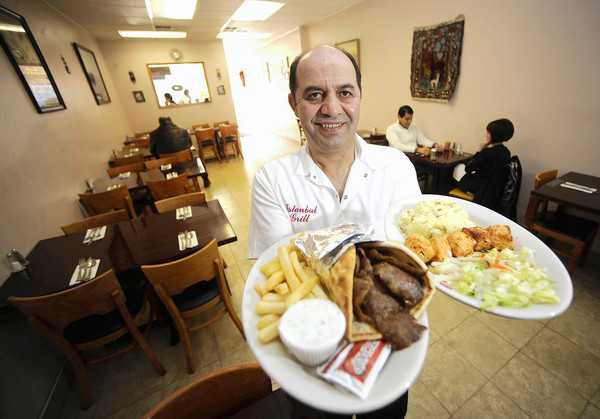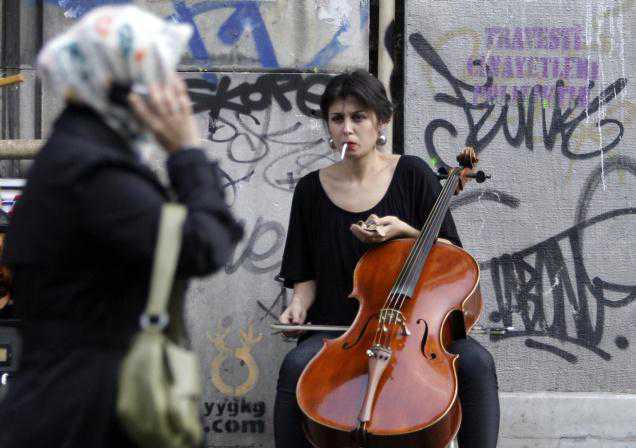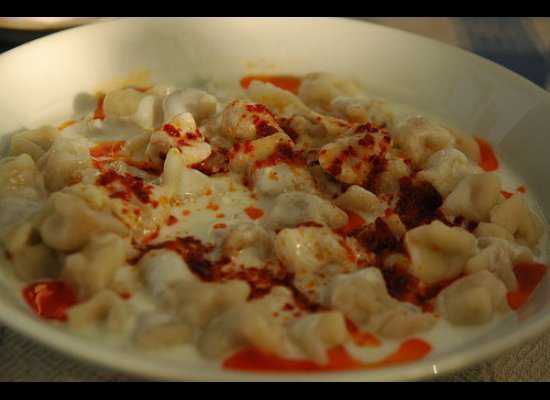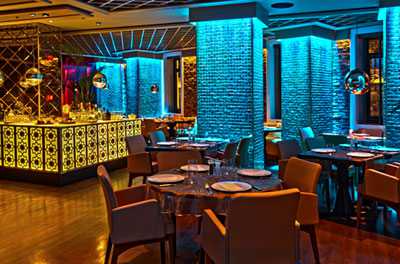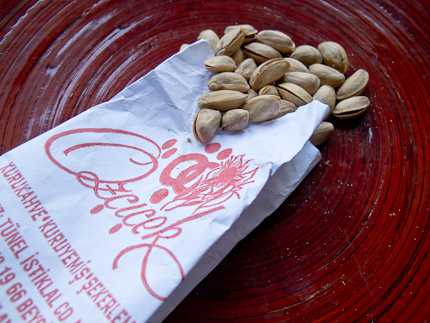The true history of the doner kebab and a visit to its glorious birthplace in Bursa, Turkey.
Doner kebabs in the doner kebab birthplace. Photo credit: Gabrielle Jackson
In my quest to get the humble kebab the recognition that it deserves, I’ve noticed that there seems to be a lot of controversy about the origin of kebabs, what constitutes a kebab and who invented them.
For clarity’s sake, a kebab is meat roasted or grilled on a stick over a fire. And from what I can gather from my travels to Greece, Turkey and Iran, everybody invented the kebab.
It may have been “invented” by medieval Persian soldiers who, for convenience, skewered their dinner on their swords and roasted it over a fire. Wikipedia seems to believe this is where it all started, so it must be true. Since the Persians were travelling everywhere to conquer new lands at the time, it could easily have travelled with them. By the same token, the Sulcuks could have done it first and taken it with them on their conquests. What is fact is that kebabs have been consumed in Greece, Turkey, Iran, India and surrounding Middle East and Near East nations for many centuries. Who first had the idea is irrelevant.
What is more certain is that the doner as we know it – the vertical spit – was invented in Bursa in Turkey in the 1870s. Mr Iskender was the first man to construct a vertical fire and roast the meat by turning it constantly in front of said fire. Doner, in Turkish, means “to rotate”. It was healthier because the fat dripped off to the bottom and could be discarded. Mr Iskender was also particular about removing the nerves and bones and ensuring that, after cooking, the meat was sliced very thinly before being served.
The return of my kebappetite
So I decided it was to Bursa I must go. I’d put it off, to be honest. After 16 days in Iran eating nothing but kebab for breakfast, lunch and dinner – OK, maybe not breakfast, but it felt like it in the end – I thought I’d never eat a kebab again. But after a week of eating fine non-kebab Turkish cuisine in Istanbul, my kebappetite was back!
I sat on the bus on the day of its return thinking about the famous Iskender kebab and my mouth was watering. I was excited about kebab again, and it felt good.
According to my half-baked research, which involved glancing at the Lonely Planet and asking the only Turkish person I knew, a place called Kepaci Iskender was actually the best place to go. The Lonely Planet said that it was hard to find good Iskender in Bursa but I stopped trusting the Lonely Planet when it got me kicked out of Iran. However, having accidentally left my notes in Istanbul, I had no choice but to ask the taxi driver to take me to the one place in Bursa I knew the name of.
He nodded and agreed when I asked if he knew it and then took me somewhere completely different. When we pulled up outside the place I had not asked to go, I put up a perfunctory argument, but he had a more convincing tone to his voice, and besides, I thought, what did the Lonely Planet know anyway? This guy would know better than all those people who had voted it a great thing to do in Bursa on Lonely Planet’s forum after following Lonely Planet’s own advice to go there. (Do these restaurants pay a commission?)
And anyway, by now, a man with a friendly face and a big smile had emerged from the hole in the wall “restaurant” I’d been brought to and was kindly holding open the door of my taxi. So I got out and went in.
Iskender kebab, a specialty
It looked like the kind of place that taxi drivers would eat in, which I generally find to be a good thing, but the pictures on the wall indicated it was also frequented by the who’s who of Turkey. Was this Bursa’s Carnegie Deli? I hoped so.
The only question I was asked was, ‘”One portion?” I nodded. I like this: they specialise. I like a place that specialises. I would happily eat forever after in restaurants that sold just one dish. OK, maybe two for the fussy. It also makes it easy to order when you don’t know the language.
The Iskender kebab is doner meat thinly sliced and layered over Turkish bread (pide), topped with fried butter and yoghurt. It usually comes with a light tomato sauce as well and is served with grilled tomatoes and peppers.
At Uludag Kebapcisi, which is where I was, the tomato sauce is poured over the pide before the meat is layered in top, but you can have more on top if you like. And I liked. A man came around with a little silver jug of sauce pouring over more tomato sauce (which I think was combined with the fried butter) for the discerning customer (ie, me).
As the only non-Turkish person in the restaurant (which incidentally seated a total of 12 people), I seemed to be causing quite a stir. Or was it that I was writing notes? Or taking photos of my food? In any case, I soon discovered that the taxi driver had done me a huge favour. I was so pleased that I had given him that 2.50 lira tip, which I was loathe to do at the time.
Uludag Kebapcisi perfects the doner
This may not be the restaurant of the direct descendants of Mr Iskender himself (as Iskender Kebapci purports to be) but Master Chef Cemal Calisir did work for the sons of Iskender Effendi for 15 years, perfecting the doner recipe before opening his own place in an old garage – where it remains today – in 1964. This restaurant has been cooking doner to his exacting standards ever since. In fact, they refused to open a branch in Istanbul for many years because they couldn’t get the meat from Bursa to Istanbul without freezing it – a sin they refused to commit. They now, however, can prepare it in Bursa in the morning and still get it to Istanbul for cooking and serving the same day, so voila, there is now an Istanbul branch.
While they won’t give you the exact recipe, they will tell you that their doner is a mix of veal and lamb meat, which they grind themselves. They have the carcasses delivered directly to their factory, where they remove the nerves of the meat and mix the “most delicious” sides together.
After sharing this wonderful information with me, the manager topped up my meat as I was nearing the end of my meal. His smile was infectious and I smiled back a smile as big as I could make it, not least because that thinly sliced meat was succulent, flavoursome and ever so moreish! And it had been seven days since my last kebab.
Five chilli theory
It seems whenever I award five chillies, I’m having a good time. Is it the food or my mood? I’m usually by myself, which makes it strange. How can I be having such a good time, I asked myself? It is certainly the routines and rituals of the restaurant, as well as the service of the staff, that are helping me to intense happiness. And that makes the five chillies that much more pleasant to give.
As I left, eventually, after eating about a kilo of meat and probably an equal quantity of fried butter, I was given a rather nice looking pen with a torch on one end. Fancy! I was begged to stay for chay or café, but I couldn’t, I needed to walk off all that meat and butter. I did stay long enough to get a few photos with the chef, manager and all-important doner, invented right there in Bursa!
The seven-hour round trip for this kebab was definitely worth the trouble.
The Iskender kebab is rightfully famous in Turkey. The only mystery is why it isn’t more famous the world over?
FIVE CHILLIES, of course.
Venue: Uludag Kebapcisi, Garaj Karsisi Sirin Sokak No. 12 Osmangazi, Bursa
www.uludagkebapcisi.biz
The German myth
NB: There is an urban myth that the doner was invented by a Turkish immigrant in Berlin. Not true, as is now clear. What this guy did invent, in the 1970s, was the takeaway kebab. “I know,” he thought. “It would be great if my customers could take away their meat and salad and I didn’t have to have them hanging around my restaurant all day making bad jokes.” And he cunningly dumped it all in a pita and bid them farewell. Incidentally, he died recently and I couldn’t verify that this was an exact quote.
This post first appeared on KebabQuest.com.
